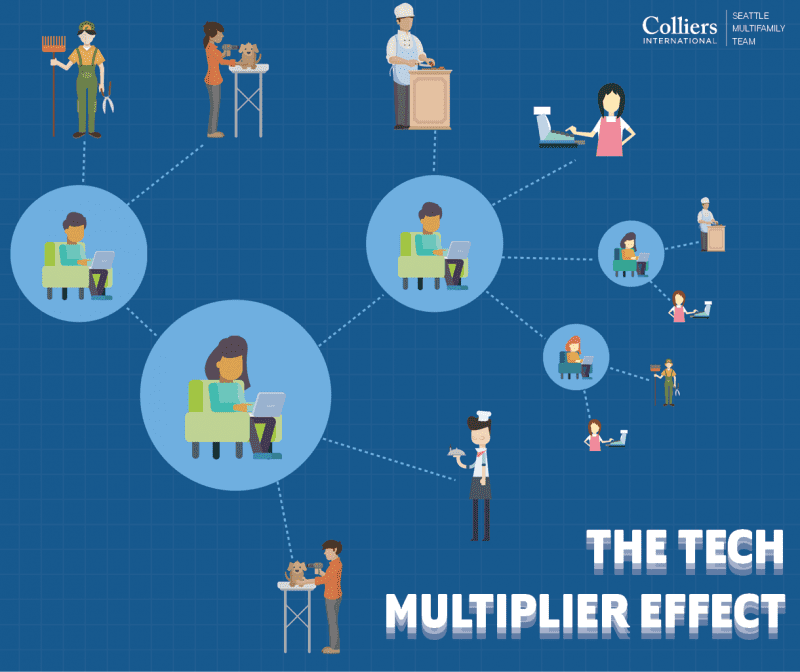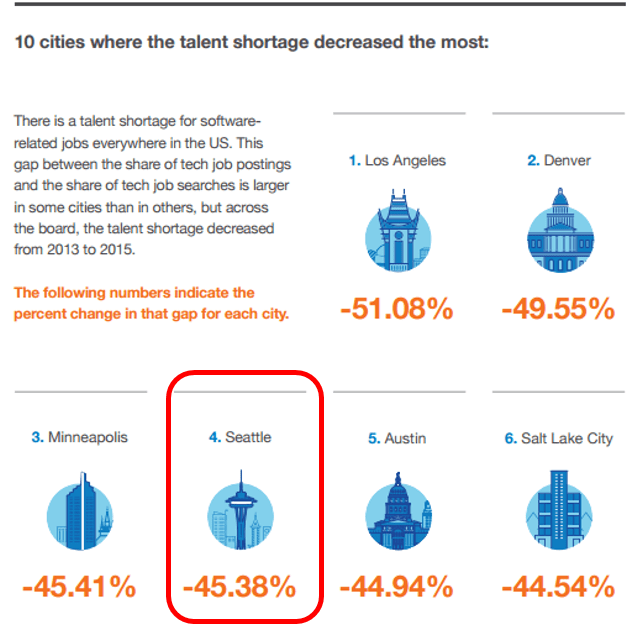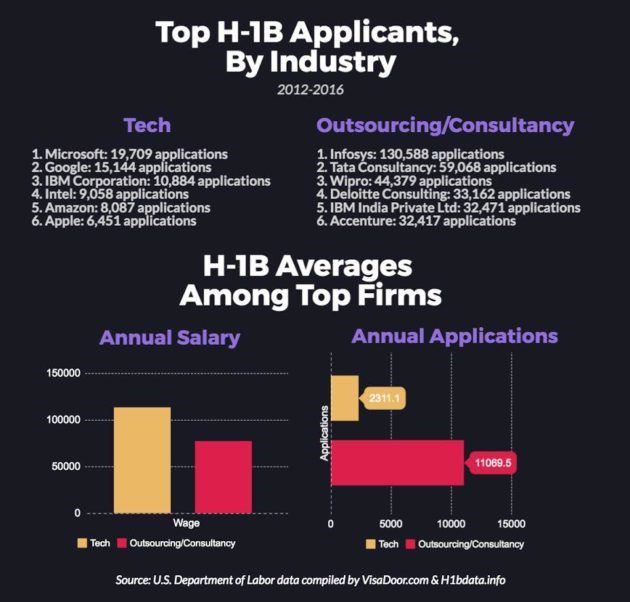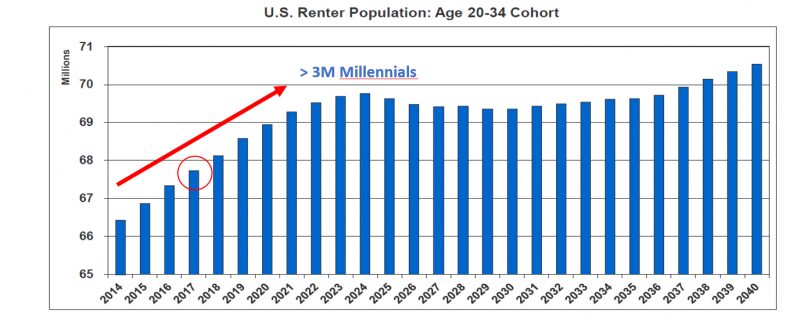An analysis of Seattle’s apartment market requires more than simply watching rental rates grow and tracking new cranes in the sky (as much as we enjoy doing both!). It’s incumbent on the savvy investor to look past the supply side and into demand – will the stellar job growth in our region continue, and if so, how can we be sure? And if “they” come, will the demand endure in five years, or ten?
I’ve written volumes about employment in Seattle – it’s one of my favorite topics. However, this week I want to move past mere predictions and explore some of the factors that could make or break this employment boom, factors that could help answer the question:
Will the good times last?
The Tech Multiplier Effect
Back in February 2015, the Washington Technology Industry Association (WTIA) reported for every tech job added to a company in Washington state, another seven jobs are added to the economy. This “7 support jobs for 1 tech jobs” multiplier effect is even higher than what Enrico Moretti noted in his seminal book, The New Geography of Jobs, where he stated that each high-tech job created five additional jobs. Either way, its great news for our region’s tech-based job growth.
Once hired in Seattle, these software developers, computer engineers, and computer systems programmers create additional jobs inside their own companies or departments, and they create jobs in the overall economy.
High-wage tech employees distribute their earnings in the local economy through grocery trips, bar tabs, shopping trips, concert tickets, and dry cleaning trips. Then these grocery stores, bars, retailers, and venues need to hire more people, too, and voila! The economy thrives.
This multiplier effect grows stronger when you add University of Washington to the mix. The University not only generates $12.5 billion in jobs, sales of goods, and other economic factors, but the rapid growth of its Computer Science program is creating an in-state pipeline for local tech employers. Zillow, Amazon, Google, and Microsoft all donate to the program, and Paul Allen recently donated a whopping $40 million. The university creates jobs and develops new talent, while employers prosper.
Local Tech Shortage Drives In-Migration
While the aggressive hiring rates of tech giants like Amazon makes it feel like Seattle is awash with tech talent, the city is actually short on talent supply to meet the growing demand. Hired, an online recruiting company, reported that 41 percent of their placements in Seattle are transplants, and the WTIA estimates that there is a 3,000 person shortage for crucial tech roles in Seattle every year. This places us #4 on the list of US cities in the most need of technology-based talent for hire.
Considering this rampant demand, it’s no surprise that Washington state is the largest importer of tech talent in the country, or that Seattle recently ranked as the 4thfastest-growing city. The University of Washington is ramping up their Computer Science department as fast as they can, and tech companies are helping, but in the meantime the same companies aren’t afraid to hire and transplant the talent they want.
All this new talent needs a place to live. Seattle has the second toughest housing market in the country, so many new residents are renters, which is good news for developers and investors alike – someone will need to live in the 19,000+ units they’re building downtown and in South Lake Union!
The Role of H-1B Visas
H-1B visas are still a crucial stopgap for Seattle’s tech shortage, ever since the program was introduced in 1990. Microsoft received more than 4,000 H-1B visas in 2016, and they’re the largest filer among domestic tech companies in the U.S. However, Google and Amazon are not far behind. Together, these tech giants bring thousands of highly skilled immigrants into the U.S. every year to fill tech shortages.
Starbucks, Facebook, T-Mobile, and Expedia are also major applicants in the state. Yet all these visas may be in jeopardy depending on Trump’s immigration agenda for the next four years. During his campaign, Trump claimed that he would end the program forever, and his administration recently suspended the expedited processing of visas.
What does this mean for Seattle employers, and for apartment investors?
A full suspension of the H-1B visa program would spell trouble for Seattle’s tech employers, particularly Microsoft. A sudden halt in their talent pipeline would not only hamper growth, but it would also stymy rental demand coming to the city and to the eastside. It’s no strange coincidence that it was the Washington State Attorney General how halted Trump’s first immigration ban.
Millennials Entering the Workforce
While this tech boom is driven by more than just the Millennial generation – there are certainly more “experienced” tech professionals working at Amazon – Millennials are the cohort that most significantly impacts the rental market.
Seattle Times recently featured a poll reporting that nearly three-quarters of Millennials are willing to rent if it meant they could live as close as possible to Seattle’s core. While the majority of those surveyed aren’t parents and were under 30, they still represent a large segment of Seattle’s workforce, and they are the demand that investors and developers need.
The Millennial boom isn’t unending, however, it has a way to go. What is considered the “renter cohort” are those aged 20 – 34 years old – currently a perfect overly with the Millennial Generation. If you look as the general age range of Millennials, 19 to 37, we are talking about 83 million people in the United States.
It is encouraging to see that the addition of renters to the market will not only grow, but remain steadily within the “renter age” range for years to come.
Technology Ecosystem Creates a Flywheel Effect
I wrote about the multiplier effect that’s happening in Seattle last year, but I also wrote about the beginnings of Seattle’s tech flywheel effect. The more mature tech companies will keep attracting top talent, which attracts other top tech companies and startups, who bring more talent! The University of Washington ups their own investment in STEM majors, creating a foundation for companies to pull from. Everything in Seattle’s tech world becomes more and more connected, and our base gets even stronger (if you haven’t already, check out the incredible Seattle Tech Universe map from Madrona Venture Group). Tech growth begets tech growth, and development begets investment.






